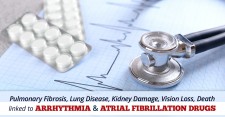
Pulmonary fibrosis (PF) is one of a family of related diseases called interstitial lung diseases that can result in lung scarring. As the lung tissue becomes scarred, it interferes with a person's ability to breathe.
San Diego, CA, September 23, 2016 (Newswire.com) - Consumer Safety Watch, a consumer advocate organization based in San Diego, CA, is warning that individuals that have been hospitalized for irregular heartbeat complications such as ventricular tachycardia (VT), ventricular fibrillation (VF), and wide complex tachycardia, as well as atrial fibrillation and paroxysmal supraventricular tachycardia may have been given antiarrhythmic medications that put them at risk for pulmonary fibrosis, lung disease, pulmonary toxicity and other dangerous side effects.
According to Alan Christopher of Consumer Safety Watch, "Amiodarone and its name brand drugs, Cordarone and Pacerone, should only be used to treat adults with life-threatening ventricular arrhythmias when other treatments are ineffective or have not been tolerated.” Yet, it was commonly pushed as a first alternative medication by manufacturers when it is believed that safer options may have been available.
"Amiodarone should only be used to treat adults with life-threatening ventricular arrhythmias when other treatments are ineffective or have not been tolerated."
Alan Christopher, Consumer Safety Advocate
Side effects of Amiodarone include the following
- Pulmonary Fibrosis
- Lung Disease
- Sudden Death/Wrongful Death
- Toxic Epidermal Necrolysis (TEN)
- Blindness
- Kidney Failure
- Respiratory Failure
- Congestive Heart Failure
- Stroke
- Liver Damage
Some questions to ask your doctor if you have been hospitalized with irregular heartbeat complications:
What is pulmonary fibrosis?
Pulmonary fibrosis (PF) is a disease marked by scarring of the tissue inside and between the air sacs in the lungs. When the scar forms, the tissue becomes stiff and thicker. This makes it harder for oxygen to pass through the walls of the air sac into the bloodstream. Once the lung tissue becomes scarred, the damage cannot be reversed. In most cases, there is no known cause for the disease. In these cases, it is called idiopathic pulmonary fibrosis or IPF.
Am I at risk for pulmonary fibrosis?
The list of substances and conditions that can lead to pulmonary fibrosis is long, and includes age, environmental and occupational exposures, including tobacco smoke, autoimmune disorders, and certain medications. Idiopathic pulmonary fibrosis sometimes runs in families, so a genetic component is suspected. Talk to your doctor about your work and health history, and be sure to mention if you have family members with IPF.
What are the symptoms of pulmonary fibrosis?
The symptoms of pulmonary fibrosis can be similar to the symptoms of other lung diseases and can include shortness of breath, cough, shallow breathing, weight loss, fatigue and aching. Some people with PF develop widening and rounding of the tips of the fingers or toes known as clubbing. If you have any of these symptoms, talk to your doctor who will conduct tests to determine if you have pulmonary fibrosis.
How can I have a good quality of life with pulmonary fibrosis?
Ask your doctor if you are eligible for pulmonary rehabilitation. Pulmonary rehabilitation is a program of education and exercise classes that teach you about your lungs and your disease, and how to exercise and be more active with less shortness of breath. The classes take place in a group setting, giving you the chance to meet others with your condition, and both give and receive support. Practicing breathing exercises may also help. Work with your doctor to brainstorm other ways you can maintain your quality of life.
Living with Pulmonary Fibrosis
What to Expect
Every person who is diagnosed with pulmonary fibrosis has a unique experience with the disease. Some people stay in stable condition for years, while others may experience rapidly-worsening symptoms and overall health. For many, it is somewhere in between. Although no one can predict your prognosis for certain, you can help yourself by maintaining a healthy lifestyle and working closely with your care team.
Managing the Disease
If you have pulmonary fibrosis there are steps you can take to stay healthy.
- Call your health care team right away if you have any symptoms or if you notice anything unusual about how you are feeling.
- Get a flu shot every year. Ask your doctor if you should have the pneumonia vaccine.
- If you smoke, quit! The American Lung Association has programs to help you.
- Avoid secondhand smoke. Ask friends and family not to smoke around you.
- If you are not enrolled in a pulmonary rehabilitation program, ask your doctor about whether you can benefit from one. This is a program that teaches you about your lung disease, how to exercise and how to manage your disease, and provides support and counseling.
- Stay active and ask about exercises that will help you to get stronger and breathe easier.
- Eat a well-balanced diet and maintain your ideal body weight.
- Try eating smaller, more frequent meals. You may find it easier to breathe when your stomach isn’t completely full.
- Join a support group to help you cope with your disease. The American Lung Association has Better Breathers Clubs all around the country. Family members and caregivers can also join.
- If your disease is making you feel anxious or depressed, talk about it with your health care team. They can get you help.
Support and Additional Information
More information is available about the dangers associated with antiarrhythmic medications like Amiodarone, Cordarone and Pacerone at: http://www.consumersafetywatch.com/
Source: Consumer Safety Watch
Share: